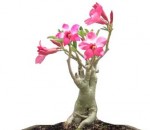 This succulent bush from the dry desert areas of East Africa and Arabia is sparsely branched with very thick stems and a swollen caudex. The fleshy leaves are spirally arranged and attached directly to the branch without a petiole. Although considered an evergreen plant it will lose its leaves in most climates during the winter. The tubular flowers have five petals, are red to pink with a lighter throat, and are about two inches long. The seed pods are silvery with a tuft of hair attached. The sap of the roots and stems is poisonous and is used as an arrow poison for hunting large game in Africa, so caution should be used with working with the plant.
This succulent bush from the dry desert areas of East Africa and Arabia is sparsely branched with very thick stems and a swollen caudex. The fleshy leaves are spirally arranged and attached directly to the branch without a petiole. Although considered an evergreen plant it will lose its leaves in most climates during the winter. The tubular flowers have five petals, are red to pink with a lighter throat, and are about two inches long. The seed pods are silvery with a tuft of hair attached. The sap of the roots and stems is poisonous and is used as an arrow poison for hunting large game in Africa, so caution should be used with working with the plant.
Position: Desert rose can be grown indoors year around but prefers an outdoor location in summer where it profits from exposure to fresh air and morning sun with afternoon shade. It is not frost hardy and should be taken indoors before temperatures drop below 40o F. It rests during the winter and should be placed in bright light rather than direct sunlight with temperatures between 54o F and 61o F.
Water: During the growing and flowering period water about once a week. Less water is required in winter.
Fertilizer: Use a liquid fertilizer every four weeks from spring until late summer; do not fertilize during the winter when the plant is resting.
Repotting: Repot every two years immediately after the rest period, pruning the roots at the same time.
Soil: Use a bonsai soil or loam, peat moss, and sand in a ratio of 2:2:1
Pruning: In early spring, cut back the thick branches. New growth can be cut back any time as needed to shape the plant. Caution: Sap is poisonous.
Wiring: Wiring must be done carefully so as not to harm the delicate bark.
Propagation: Cuttings; take 2-4” cuttings and let them dry out for three to four days before planting them in mixture of sand and peat in equal amounts.
